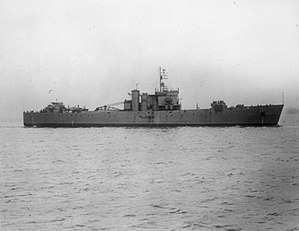HMS Bruiser (F127)
HMS Bruiser was built as a Landing Ship, Tank (LST(1)) at Harland and Wolff. Launched in October 1942 and commissioned the following March, she saw service as part of the Allied invasion of Italy.
 HMS Bruiser | |
| History | |
|---|---|
| Name: | HMS Bruiser |
| Ordered: | 6 March 1941[1] |
| Builder: | Harland and Wolff |
| Launched: | 24 October 1942 |
| Completed: | 2 April 1943 |
| Commissioned: | 12 March 1943 |
| Out of service: | 1946 |
| Identification: | Pennant number: F127[1] |
| Fate: | Sold for merchant service 1946. Scrapped 1968 |
| General characteristics | |
| Type: | Landing Ship, Tank Mark I |
| Displacement: | 3,620 |
| Speed: |
|
| Capacity: | 13 Churchill infantry tanks, 27 vehicles, 193 men |
| Complement: | 169 |
| Service record | |
| Operations: | |
Design and development
Bruiser was the second of the LST Mk.1 class ships which could carry 13 Churchill tanks, 27 other vehicles and 193 men. It had a high speed even when laden for the assault (about 18 knots) but did not have a shallow draught, which meant that a 140 ft (43 m) long bow ramp had to be added and this took up a lot of room inside the ship.
Bruiser had only two sister ships, as plans to build more in the United States led instead to a simpler though slower design capable of similar capacity but with a much shallower draught.
Service
Bruiser took part in the Salerno landing[2] in 1943. In 1944, she was refitted as a "fighter direction ship", for use during the Normandy landings in controlling fighter aircraft by ground-controlled interception. Later in 1944 she took British troops back into Athens in Greece[2]. Bruiser was sold into merchant service in 1946.
Merchant service
Bruiser was sold in 1946 for merchant service as Nilla. In 1951 she was converted to a cargo liner and renamed Silverstar. In 1957 she became Ciudad de Santa Fe and was broken up in Argentina in 1968.[3]
See also
References
- "HMS Bruiser (F 127)".
- "bbc".
- "Bruiser (5074707)". Miramar Ship Index. Retrieved 31 January 2020.